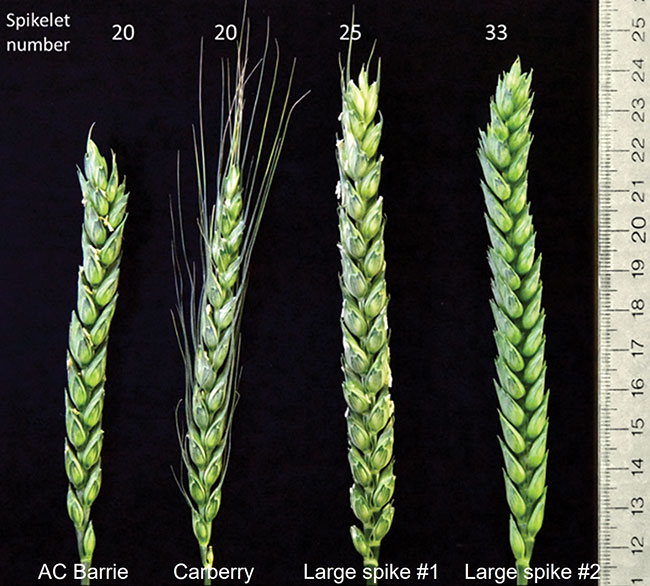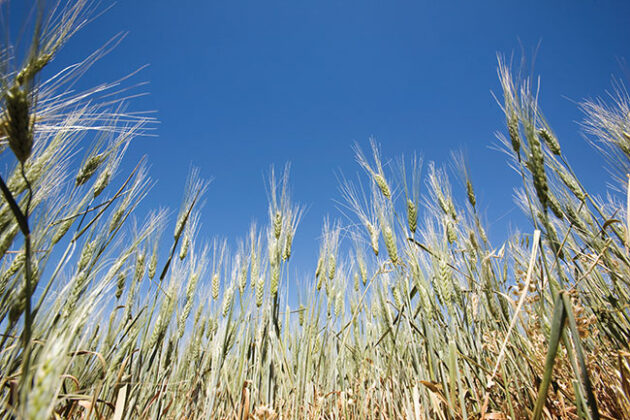
Features
Cereals
Ramping up wheat yield potential
Research to improve spike traits could increase yield potential by as much as 20 per cent.
March 15, 2023 By Carolyn King
 Two Canadian wheat cultivars and two wheat lines with large spikes.
Photo Raju Datla, Global Institute for Food Security.
Two Canadian wheat cultivars and two wheat lines with large spikes.
Photo Raju Datla, Global Institute for Food Security. One of the key characteristics influencing grain yield potential in wheat is the number of grains in the spike. If the grain number is relatively low, then the spike will have fewer places for storing the photosynthetic sugars for grain filling, and the yield will be low.
So, Raju Datla is leading a four-year project that aims to increase the number of grains per spike to improve yield potential in Canadian spring wheat varieties.
“There is still an important potential for improving the grain number within the wheat spike, which directly contributes to the yield,” explains Datla, a senior scientist with the Global Institute for Food Security (GIFS) at the University of Saskatchewan. “We believe there is a 10 to 20 per cent higher yield potential we can capture beyond the current Canadian spring wheat cultivars.”
The project started about two years ago. As a first step, Datla and his research team screened diverse wheat lines from Canadian and international germplasm sources focusing on four spike characteristics: larger spikes, more spikelets per spike, more florets per spikelet and more grains per floret. They also looked for lines with stronger spike stalks that are able to hold up spikes with many more grains.
Through this work, they found some wheat lines with up to about 70 to 80 grains per spike, whereas most current Canadian spring wheat varieties have about 40 to 50 grains per spike.
The team has selected about four promising lines for each of the four spike characteristics.
“Improving all four characteristics has the potential for increases of up to about 20 to 30 more grains per spike compared to our benchmarks, AC Barrie and Carberry, two widely grown Canadian spring wheat cultivars,” he says. Later in the project, when they introduce a particular trait into current elite cultivar backgrounds, there could be differences in how the trait expresses itself. Those differences would influence how much a breeding line’s yield potential is increased.
At present, the researchers are investigating how spike development in these promising lines is different from spike development in lines like AC Barrie and Carberry.
The next step in the project is to determine the genes underlying the traits of interest. For example, one of the traits they are examining is the multi-ovary trait. Datla explains that normally only one grain is produced per each floret, but wheat lines with this multi-ovary trait can have two or three grains per floret. So, moving just this one trait into a wheat variety could make a big difference in the grain number per spike and yield potential.
Next, they will map the locations of the traits on the wheat genome and develop molecular markers that are closely linked with these traits.
Then, they will work on introgressing the desired spike traits into elite Canadian spring wheat cultivar backgrounds using their markers to track the presence of the traits in their breeding materials. Then they will assess the performance of their lines under field conditions, comparing them to standard Canadian spring wheat cultivars.
In these final steps, Datla and his team, which includes Leon Kochian of GIFS and Daoquan Xiang of the National Research Council of Canada, will be collaborating closely with several spring wheat breeders: Curtis Pozniak with the Crop Development Centre at the University of Saskatchewan, Richard Cuthbert with Agriculture and Agri-Food Canada (AAFC) in Swift Current and Santosh Kumar with AAFC in Brandon.
Overall, the goal is to develop wheat lines that not only have more grains per spike and a strong spike stalk, but also satisfy all the other requirements for commercial Canadian spring wheat varieties.
The three main funders for this project are the Saskatchewan Wheat Development Commission, Alberta Wheat Commission and Manitoba Crop Alliance.

Key characteristics influencing grain yield potential in wheat is the number of grains in the spike.
Photo Tyler Olson/adobe stock.
The bigger picture
“We are hoping what we find here in this project could contribute to both the fundamental and applied opportunities for the Canadian wheat crop,” says Datla.
Canadian wheat breeders could use the project’s wheat lines with enhanced spike traits for cross breeding and the project’s markers for screening for these traits in their breeding materials. These breeding tools could result in Canadian wheat lines with significantly higher grain yield potentials.
Producers would benefit from increased wheat production per acre. And, increased Canadian wheat production would contribute to improvements in global food security.
As well, the developmental, genetic and genomic information generated by the project will help to augment scientific understanding of wheat spike traits. And, that could open more opportunities for further improvements in wheat yields.
Datla also points out that this spike project is just one part of his research group’s larger effort to increase wheat yields.
He explains that the spike project focuses on enhancing the plant’s “sink” capacity by providing more places in the spike to accumulate the photosynthetic sugars. His team is also conducting other studies to enhance sink capacity.
They are also investigating ways to improve the wheat plant’s “source” capacity, its capacity to produce photosynthate, which relates to overall plant performance. And, they are looking into possibilities for enhancing the plant’s ability to move the photosynthates from the source areas to the spike for grain filling.
With the advances that could result from these studies, the potential for ramping up Canadian wheat production looks very exciting.